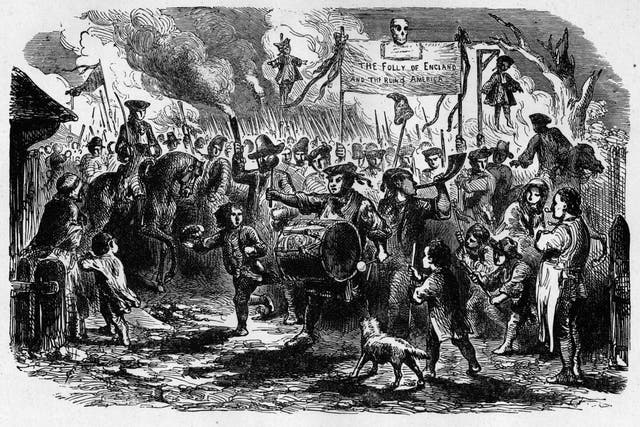
The measure that imposed a tax on all printed materials inspired widespread outrage and even violence among the colonists.
Updated: March 18, 2024 | Original: August 14, 2015

Andrew Oliver could have been excused if he didn’t feel very welcome in his hometown of Boston. After awaking on August 14, 1765, the wealthy 59-year-old merchant and provincial official learned that his effigy was hanging from a century-old elm tree in front of Deacon Elliot’s house. After dusk, angry Bostonians paraded Oliver’s likeness through the streets and destroyed the brick building he had recently built along the waterfront. In case Oliver still hadn’t received the hint, the mob beheaded his effigy in front of his finely appointed home before throwing stones through his windows, demolishing his carriage house and imbibing the contents of his wine cellar.
Oliver had become the public’s enemy after news arrived from England weeks earlier that he would be responsible for the local implementation of a reviled law imposed by the British government—the Stamp Act.
Approved by Parliament on March 22, 1765, the measure imposed a tax on all printed materials for commercial and legal use—including wills and deeds, newspapers, pamphlets and even playing cards—as a means to pay for the deep debt Great Britain had incurred protecting the American colonies from French and Native American forces during the Seven Years’ War, which ended in 1763. The Stamp Act also denied offenders a trial by jury because colonists had a habitual tendency to find their smuggling peers not guilty.
The Stamp Act was the first direct tax on internal commerce, rather than a duty on external trade goods, imposed on the American colonies, and it had colonists who believed that only their own representative assemblies could levy direct taxes in an uproar. When news of the Stamp Act arrived in May, newly elected Patrick Henry railed against the law in the Virginia House of Burgesses and led the adoption of the radical Virginia Resolves, which denied the right of an unrepresentative Parliament to tax the colonies.
In Boston, opposition moved from fiery rhetoric to inflamed violence, fanned by a secret organization known as the Loyal Nine. The clandestine group of artisans and shopkeepers printed pamphlets and signs protesting the tax and incited the mob that ransacked Oliver’s house.
The Stamp Act commissioned colonial distributors to collect a tax in exchange for handing out the stamps to be affixed to documents, and Oliver, without his knowledge, had been appointed the distributor for Massachusetts. The day after his property had been destroyed, Oliver resigned a position he never asked for and one he never held, since the Stamp Act wasn’t due to take effect until November 1.
The resignation, however, didn’t douse the violent protests in Boston. On August 26, another mob attacked the home of Oliver’s brother-in-law—Lieutenant Governor Thomas Hutchinson. The rioters stripped the mansion, one of the finest in Boston, of its doors, furniture, paintings, silverware and even the slate from its roof.
Similar riots broke out in seaports from Portsmouth, New Hampshire, to Savannah, Georgia, and forced the resignations of crown-appointed officials. Mobs turned away ships arriving from Great Britain with stamp papers. The Loyal Nine expanded and became known as the Sons of Liberty, which formed local committees of correspondence to keep abreast of protests throughout the colonies.
In October, delegates from nine colonies traveled to New York to attend the Stamp Act Congress, which drafted a “Declaration of Rights and Grievances” that affirmed that only colonial assemblies had the constitutional authority to tax the colonists. Merchants in seaports such as Boston, New York and Philadelphia united to boycott British imports, which prodded British merchants to lobby for the Stamp Act’s repeal.
The intimidation campaigns and boycotts worked. When November 1 arrived, the mass resignations of the stamp distributors impeded the administration of the tax. In many parts of the colonies, printers proceeded with business as usual. When it proved impossible to implement the Stamp Act, Parliament repealed it almost a year to the day after it had approved it. However, it also passed the Declaratory Act to reaffirm its authority to pass any legislation impacting the colonies.
When news of the Stamp Act’s repeal reached Boston in May, the Sons of Liberty returned to the elm tree from which they had dangled Oliver’s likeness, this time to hang celebratory lanterns, not effigies, from its mighty boughs. Every year on August 14, the Sons of Liberty gathered under the shade of the elm, which they christened the “Liberty Tree,” to commemorate the 1765 protest.
The issue of taxation without representation continued to fray the relations between the American colonies and the mother country over the next decade until war broke out in 1775. During that summer, British soldiers and Loyalists under siege in Boston took axes to the Liberty Tree and chopped it into firewood. Although the tree was missing when the patriots returned to Boston after the British evacuation, they still gathered around its stump on August 14, 1776, to commemorate the protest from 11 years earlier that was one of the first rebellious steps on the path to revolution.
The Sons of Liberty also never forgot Andrew Oliver, whose reputation improved little among Boston’s patriots after becoming lieutenant governor in 1770. When Oliver passed away four years later, a Sons of Liberty delegation was at his graveside to give three cheers as his coffin was lowered into the ground.
Stream American Revolution documentaries and your favorite HISTORY series, commercial-free.